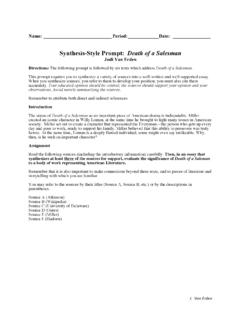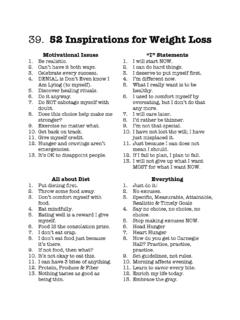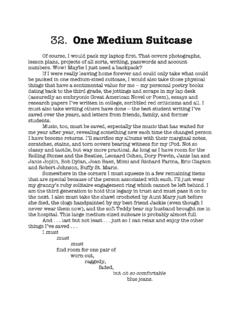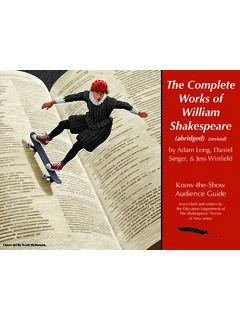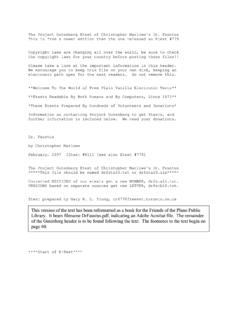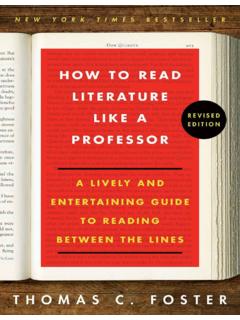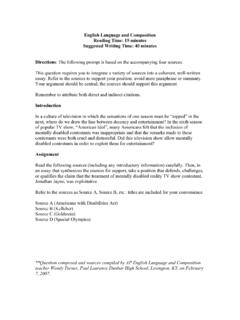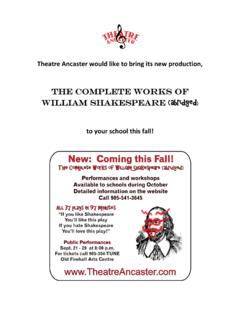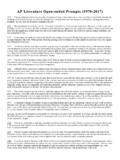Transcription of WHAT IS POETRY? - MsEffie
1 what IS poetry ? It is words arranged in a rhythmic pattern with regular accents (like beats in music), words which are caref ully selected for sound, accent and meaning to express imaginatively ideas and emotions. Each poem has rhythm, melody, imagery, and form. SOME ELEMENTS OF poetry what IS RHYTHM? Rhythm is produced by a recurring pattern of stressed and unstressed syllables and pauses. Each poem has a metric pattern (except in free verse which has no metrical pattern since it is based on the natural cadences of speech). That is, the accents of the syllables in the words fall at regular intervals, like the beat of music. This pattern is described by indicating the kind and number of feet in a regular verse line.
2 THE FOUR M05T-USED KIND OF FEET No. of Syllables Technical Name of Kind of Foot Accented = ( / ) DUMM Unaccented = (~ ) de Such as 2 iamb, iambic ~ / de DUMM ~ / ~ / a WAY, i WILL 2 trochee, trochaic / ~ DUMM de / ~ / ~ COM ing, DO it 3 anapest, anapestic ~ ~ / de de DUMM ~ ~ / ~ ~ / can non ADE, let us IN 3 dactyl, dactylic / ~ ~ DUMM de de / ~ ~ / ~ ~ VIC to ries, TWO of them Less Often Used: spondee, spondaic (DUMM DUMM) pyrrhus, pyrraic (de de) The beat of poetry feet in called meter. Marking lines as the following are marked to show feet or meter is called scansion: ~ / ~ / ~ / ~ / The stag l at eve | had drunk | his fill This line is iambic tetrameter.
3 If meter should vary within a line, it is called inversion. The number of feet in a line is expressed as follows: 1 foot monometer 6 feet hexameter 2 feet dimeter 7 feet heptameter 3 feet trimeter 8 feet octameter 4 feet tetrameter 9 feet nonameter 5 feet pentameter Pauses do not usually figure significantly in scansion, but they do affect the rhythm of a line, just as they affect the rhythm of music. There are three types of pauses: End-stopped which is a pause at the end of a line. Caesura which is a pause that occurs within a line. Enjambement which is a line that runs over to the next line without a pause. what IS MELODY? Like music, each poem has melody ( , sound devices).
4 A poet chooses words for their sound, as well as for their meaning. Rhythm, of course, is a kind of sound device based upon pattern. Euphony (literally good sound ) and cacophony (literally bad sound ) contribute to producing melody, or a musical quality in verse. One of the principle tools of melody is rhyme that is where two words have the same sound on their last accented vowel preceded by different consonants, such as: Single (Masculine) Rhyme dame, same love, dove Double (Feminine) Rhyme napping, tapping weather, heather Triple Rhyme mournfully, scornfully victorious, glorious Other rhyming terms include: Sight (Eye) Rhyme in which two words look alike but don t sound alike, such as LOVE and JOVE or DAUGHTER and LAUGHTER.
5 Slant (Imperfect) Rhyme in which two words are nearly rhymed but have a slight variation in vowel sound, such as LAKE and FATE. NOTE: Sometimes what is now a sight rhyme was once a true rhyme, but pronunciation changes have occurred, such as AGAIN and RAIN. Identical Rhyme (Rime Riche) in which two words are spelled differently but have the same pronunciation (also called homonyms), such as TWO and TOO or RITE and RIGHT. End Rhyme in which the rhyming words occur at the ends of lines of poetry . Internal Rhyme in which the rhyme occurs inside a line, such as Let s BEAT the HEAT. Besides rhyme, poets also use other sound effects: Alliteration is the repetition of similar speech sounds in closely associated words or syllables.
6 There are three kinds of alliteration: Consonantal Alliteration Peter Piper picked a peck of pickled peppers. Vowel Alliteration Apt alliteration s artful aid is often an occassional ornament in prose. Internal Alliteration The moan of doves in immemorial elms, And murmuring of innumerable bees. Assonance is the repetition of identical vowel sounds in syllables that have different consonant sounds, such as LAKE and FAKE or In Xanadu did Kubla Khan (which repeats only vowel sounds). Consonance is the repetition of identical consonant sounds in syllables that have different vowel sounds, such as BILL and BALL or BORN and BURN. Onomatopoeia is the use of words which sound like their meanings, such as HISS, MURMUR, BUZZ, and so on.
7 A really skillful poet may merely use S-sounds in a poem about a snake, rather than the word HISS. what IS IMAGERY Each poem also uses imagery which is produced by figures of speech. These take many forms, but all are rhetorical methods which affect the literal meaning of words. Let s start by looking at single words which appear synonymous: dumb, stupid, slow, uneducated, ignorant, obtuse, dense smart, clever, shrewd,brilliant, intelligent, with-it, cagey skinny, slender, thin, emaciated, scrawny, lithe, lean, underweight fat, chubby, plump, corpulent, pudgy, junoesque, zaftig. overweight home, house, shack, bungalow, mansion, crib, pad, hearth, quarters Even though the denotation (literal meaning) of the words appears synonymous, the connotation (figurative meaning) is different.
8 Figures of speech work the same way. Imagery is the use of figures of speech which are concrete it always refers to a sensory experience. The sun perceived by the senses is concrete; the enlightenment associated with it is abstract (perceived by the intellect, not the senses). Thus, we have the image of a peacock which serves as the vehicle of the comparison. Its theme or meaning may be something abstract like vanity or beauty, but the image must be concrete. Generally speaking, there are three kinds of figures of speech: comparisons, substitutions, and ambiguities. Comparisons Analogy A comparison of two things, alike in certain aspects a simile is an expressed analogy; a metaphor is an implied one.
9 Metaphor Two unlike things compared directly, implying several similar qualities, such as The river is a snake which coils on itself . Simile Two unlike things compared using like or as, implying only one similar quality, such as The man paced like a hungry lion. Personification Giving human qualities to inanimate objects or non-human creatures, such as The trees danced in the breeze. Apostrophe Addressing some abstract object as if it were animate, such as O world! Tell me thy pain! Thus, it is a kind of personification. Allusion Referring metaphorically to persons, places or things from history or previous literature, with which the reader is expected to have enough familiarity to make extended associations, such as The new kid is as mean as Grendel and twice as ugly or He must think he s some kind of Superman.
10 Allegory A form of extended metaphor in which objects, persons, and actions in a narrative are equated with meanings that lie outside the narrative itself, such as Everyman. Special kinds of allegories include the fable and the parable. Conceit An extended or elaborate metaphor which forms the framework of an entire poem with all comparisons being interrelated in some way, such as what Is Our Life? by Raleigh. Symbolism The use of one object to represent or suggest another object or an idea. Thus, a rose might be used to symbolize the loved one or love in general, depending on the context. Substitutions Metonymy Substitution of one word for another closely related word, such as The pot s boiling or The White House announced.
